Your line gets used and abused year after year and lets face it; it’s not the most “fun” thing to buy at the pro shop. That said, having the best fishing line for bass makes a big difference when it comes time to hook something.
I’ve lost countless bass due to poor line choices and bad line management. Folks, this is a simple purchase, don’t overcomplicate it.
The eight choices in this guide are the best options across the board. Let’s take a look.
- Sufix Advance Clear
- Kastking World’s Premium Monofilament Line
- Berkley Vanish Fluorocarbon Fishing Line
- Kastking Superpower Braided Line
- Sufix Ice Magic
- Stren High Impact Monofilament
- Berkley Trilene XL
- Sunline Super FC Sniper
- How to Choose the Best Fishing Line for Bass
- Best Fishing Line for Bass Overall
- Best Monofilament Line for Bass
- Best Fluorocarbon Line for Bass
- Best Braided Line for Bass
- Best Cold Weather Fishing Line
- Best High Impact Line
- Best Fishing Line for Spinning Bass Reel
- Best Fishing Line for a Bass Baitcaster
- What Are The Different Types of Fishing Lines?
- What Pound Test Should You Use
- What Color Line Should You Use
- How Does Fishing Line Type Impact Setting The Hook
- Understanding The Terminology
- Final Thoughts
How to Choose the Best Fishing Line for Bass
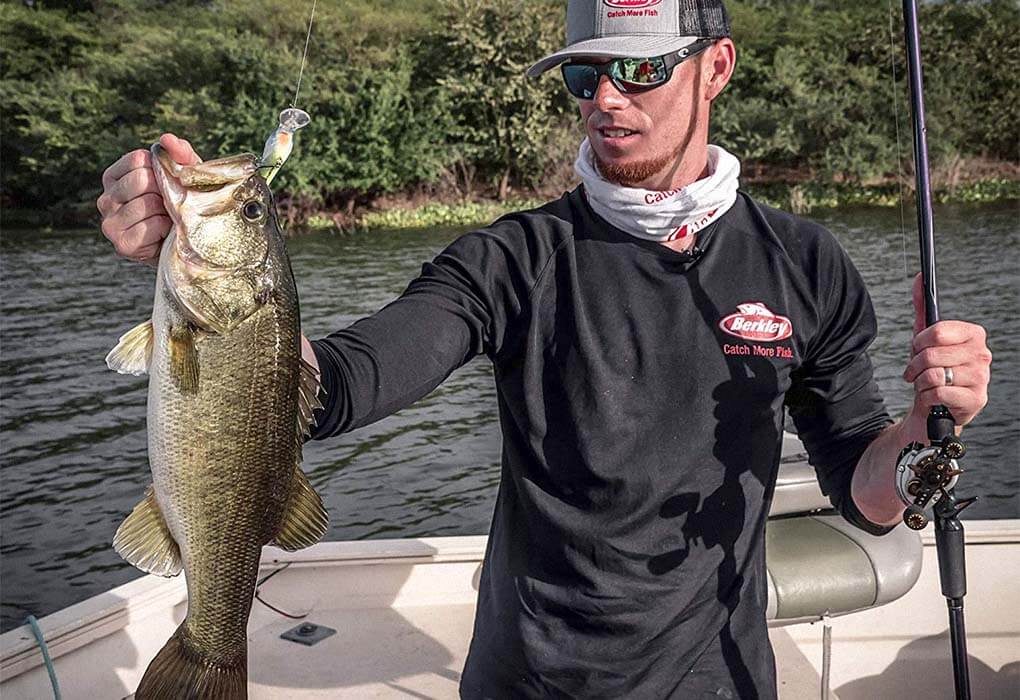
When it comes to fishing line for bass, it’s important to understand the components that make up a good or bad line. Here they are:
Stretch
The stretch of a line impacts the sensitivity and hooksetting capabilities of the line. For example, if the line has no stretch it’s more sensitive because every little nibble will tug on it.
But, high stretch lines also make it easier to set the hook because they’re less likely to fly out of the fish’s mouth. Monofilament line has the most stretch and fluorocarbon and braided have less.
Visibility
Bass are naturally sketched out so whatever you can do to disguise yourself is a smart move.
Fluorocarbon line is generally considered “invisible” in the water and that’s the main reason why a lot of people use fluorocarbon leaders with their line.
Pound Test
The pound test of your line refers to the lines overall strength in pounds. Basically, it’s the amount of weight a line can handle before snapping.
What is the best pound test line for bass fishing?
The best pound test line for bass fishing is usually in the range of 4-8lbs.
However, this can change for each scenario depending on how big your lure is and where you’re fishing.
Best Fishing Line for Bass Overall
SUFIX ADVANCE CLEAR
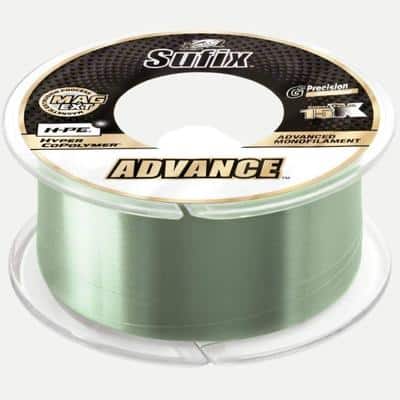
Specs
- Type: 4-25lb
- Color: Clear
- Length: 250-330 yards
- Material: Monofilament
Pros
- 50% lower stretch
- Reduced UV light absorption makes it more invisible
- Great sensitivity
Cons:
- Concerns over abrasion resistance
The Sufix Advance is a great line for the price point and is my favorite because of the line memory and reduced stretch.
When you’re fishing for bass, using monofilament can be the standard for most anglers and the stretch that you experience often leads to missed strikes and lost opportunities.
This line offers 50% less stretch which improves the sensitivity allowing you to feel smaller nibbles. It also means you can catch more panfish too.
The reduced light absorption makes it less visible in the water so it doesn’t cast shadows and spook the bass too.
As for abrasion resistance, the line will start to develop hairs over time and split so it’s a good policy to snip the end and replace after each trip anyway. ț
Proper line management should do the trick.
Best Monofilament Line for Bass
KASTKING WORLD’S PREMIUM

Specs
- Type: 4-30lb
- Color: Black, blue, white, green, pink, red, yellow
- Length: 300-600 yards
- Material: Monofilament nylon
Pros
- High abrasion resistance for durability
- Easy to tie knots
Cons
- Higher chance of air knots
KastKing is supreme in the online fishing community, and they produce a lot of amazing products. Here we have a mono line that never sinks so it works well with your topwaters.
When you’re casting into heavy cover, rocks, and stumps, you need to make sure you have a line that will offer protection from structure but also sensitivity so you can feel those small nibbles.
They offer 300 yards in a variety of pound tests ranging from 4-30 pounds. The line is thinner, less visible, and stronger than a lot of the competition.
Best Fluorocarbon Line for Bass
BERKLEY VANISH
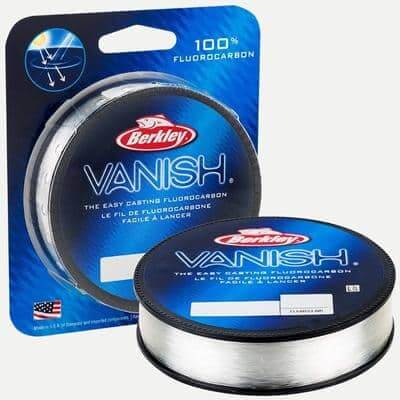
Specs
- Type: 2-100lb
- Color: Clear, Clear-Gold, Clear-Crimson
- Length: 110-2000 yards
- Material: Polyvinylidene fluoride
Pros
- Well known brand
- Great abrasion resistance
- Virtually invisible underwater
Cons
- Potential quality control issues
It’s in the name, so you likely guessed it. Here we have a fluorocarbon line that does a great job of vanishing before the eyes of your target bass.
The ultimate goal with this type of fishing line is to prevent the bass from seeing it, and this one does a great job of that.
For this reason, this works well along your favorite fly line. I recommend using it as a leader if fly fishing is your game.
Berkley is a well known and respected brand in the fishing community, so you know you’re getting the best fishing line products.
Best Braided Line for Bass
KASTKING SUPERPOWER BRAIDED

Specs
- Type: 6-150lb
- Color: Gray, green, blue, yellow, multi-color
- Length: 327-1097 yards
- Material: Ultra High Molecular Weight Polyethylene Braid Fiber
Pros
- Serious line strength results in longevity
- Small diameter for easy knot tying
Cons
- The line has a black powder on it
Let’s get down to business and talk about the best color braided fishing line for bass fishing.
The fishing line offers incredible strength, and they’ve even improved it with a smaller diameter, which makes it easier to tie knots.
With low memory, you can cast further and experience fewer wind knots. This line from KastKing also offers great abrasion resistance, as you would expect from a high-quality braided line.
Best Cold Weather Fishing Line
SUFIX ICE MAGIC
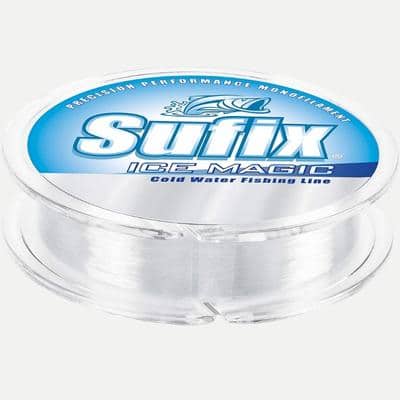
Specs
- Type: 2-8lb
- Color: Clear
- Length: 100 yards
- Material: Monofilament
Pros
- Great for ice fishing
- Completely clear for clear cold water
- Designed to repel water for ice fishing
Cons
- Issues with memory
If you’re primarily an ice angler or even prefer to fish during cold weather, the Sufix Ice Magic is the line you want. It’s an all temperature line that is designed to reduce memory and limit ice buildup.
One issue that a lot of angler run into in the winter is water buildup on the line which then turns into ice and creates a big mess on the eyes and in the spool. Sufix Ice Magic helps prevent this.
The truth is, it’s not perfect and there is still quite a bit of memory in this line but it’s affordable and clear which makes it a great choice for ice fishing or cold weather angling when the water is still, calm, and clear.
Best High Impact Line
STREN HIGH IMPACT MONOFILAMENT
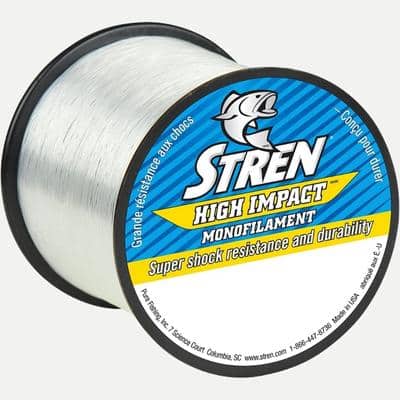
Specs
- Type: 10-30lb
- Color: Clear, High-vis Green, Low-vis Green, Blue
- Length: 400-1275 yards
- Material: Synthetic Fiber
Pros
- Works great for hard striking bass
- High and low-vis options
Cons
- More line memory than some other monofilament
Bass are the fighters of the water so you need a fishing line that will handle that hard strike without breaking.
Stren High Impact line is great for handling bass and having the visibility options is great as well.
I recommend keeping both high and low-vis in your tacklebox and treating it as a leader for your backing.
Best Fishing Line for Spinning Bass Reel
BERKLEY TRILENE XL MONOFILAMENT

Specs
- Type: 4-20lbs
- Color: Clear
- Length: 1000 yards
- Material: Monofilament
Pros
- Simple but effective and reliable
- Sensitive and versatile for a lot of lures and situations
- Great for finesse angling
Cons
- Will start to show memory after a while
Call me basic if you want but I still think Berkley Trilene is one of the most reliable lines on the market.
It’s the best bass line for spinning reels because it’s easy to manage, quick to spool, and smooth to allow for optimal casting distance when working with lighter baits.
Even though this would be considered a “light-duty” line, it has decent pulling power as well.
I just struggle to get away from the basics and this is one of the most reliable fishing lines that has been on the market forever.
If you feel overwhelmed by the options and can’t figure out what line to use, this is the best option.
Best Fishing Line for a Bass Baitcaster
SUNLINE SUPER FC SNIPER

Specs
- Type: 5-20lb
- Color: Clear
- Length: 200 yards
- Material: Polyvinylidene Fluoride
Pros
- Optimal abrasion resistance for working structure
- Prevents nesting in baitcasters
- Low memory
Cons
- Pricey for not that much line
When you’re dealing with a baitcaster for bass, you’re likely looking for a few features in the best fishing line.
You want a line with good abrasion resistance for working around weeds, rocks, and other structure.
You probably need low memory to prevent the line from looping up and you also want something that won’t tangle easily in the reel.
The Sunline Super FC Sniper is the best line you can purchase for your baitcaster mainly because of how it can handle abuse.
You’ll still want to have some experience under your belt like most people do by the time they get around the fishing baitcasters but it’s one of the best options money can buy.
What Are The Different Types of Fishing Lines?
If you choose the wrong fishing line type for the situation, you’ll have reduced casting distance, more friction, and even more line breaks, resulting in lost lures (if you’re anything like me, you have “lucky” lures so you’d hate to lose them)!

Let me explain the three types of line and how to implement bass fishing techniques with each line.
Monofilament Line
Monofilament line is the most common fishing line for bass fishing for a few reasons.
First, it’s usually the best for finesse style fishing, which is a lightweight fishing style used to catch smaller fish with a sharper bite. (AKA bass)
If you decide to go with monofilament, you’ll have the best fishing line for bass spinning reels. When you combine it with a spinning reel, you have a great lightweight fishing rig that works well for finesse fishing.
The main reason people turn to this line for bass fishing is that it helps offer more flexibility and comfort when casting.
The lightweight line allows you to use the lure to guide your cast.
It also has excellent shock absorption so you can get a nice hookset.
Bass strike quickly and hard, but they’re not afraid to swim away if you don’t react quickly enough.
Another advantage of monofilament line is that it floats on the top of the water, which makes it great for topwater lures (of course).
When to use it
If I had to give you a precise time that it’s ideal to use this type of line I would say all the time. This line is your “run of the mill” have all the time fishing line, and you would want to build from here.
My favorite thing is that you can use it with almost any type of lure. Swimbaits, crankbaits, jigs, soft plastics, and jerkbaits all work with mono as your main line.

When you’re entirely new to fishing, you’ll want to stick with monofilament 100 percent of the time until you get the hang of things.
Trying to play around with different fishing lines will only complicate your fishing. There are many other variables to worry about that are more critical.
Now, while I do say to use monofilament line the majority of the time, there are some drawbacks to that. Mono offers the least abrasion resistance and moderate visibility in the water when compared to some other options.
This means that you won’t be able to throw this into heavy cover because you’ll get hung up and possibly snap your line.
The visibility of mono isn’t too bad as long as you’re fishing the right color for the conditions.
I suggest always going with a clear mono line because it offers the most versatility, and you don’t have to overthink about the conditions you’re dealing with each day.
Monofilament line has a few bonuses as well. Mono typically has a smaller diameter than the others, which means it won’t sink as fast as fluorocarbon or braided fishing line.
It makes it a great line for topwaters because you can present them more properly without dragging them down with the line.
If visibility is your number one issue, I would suggest a monofilament fluorocarbon combination.
Fluorocarbon Line
The next type of fishing line you’ll hear about is fluorocarbon. This line is polyvinylidene fluoride, and it’s denser than monofilament.
This point means that the line will sink faster than mono, so you need to be careful where you fish it and how you present it to the bass.
That said, fluorocarbon has a wide assortment of advantages to monofilament. First, it’s more optically dense, which means it doesn’t reflect light as much as mono.
As a result, you have a line that is virtually invisible in the water.
When you have a fishing line that the bass can’t see, you have yourself a bass on the hook. Due to the low visibility of the line, you’ll see fluorocarbon used as a leader in many fishing applications.
Another bonus of fluorocarbon line is the fact that it offers much better abrasion resistance compared to monofilament.
The fishing line is more dense and sturdy, so you can fish heavy cover and have an easier time hiding it when you do.
When to use it

I recommend using a fluorocarbon leader in almost all situations, especially in clear water.
You don’t need to spool your entire reel full of expensive fluorocarbon line that may never even leave the reel.
You’ll want to fill your reel almost entirely with monofilament and then tie off a few yards of fluoro at the end for the reduced visibility and increased strength.
One other thing worth mentioning is that the fluorocarbon line is neutrally buoyant, which means it will sink more than mono or braided line.
Because of this, you wouldn’t want to fish topwater lures using this type of line because it will mess up your presentation.
While you’re trying to create the right action on the lure, the line will continually pull it underwater.
If you’re looking for improved abrasion resistance and you’re fishing more open clear water those are the times I would suggest using fluorocarbon line over monofilament.
Braided Fishing Line
The granddaddy of all fishing lines is braided lines. Here we strands of line woven together to a taut and small diameter.
The end result is a strong fishing line with no flexibility at all. These lines are highly abrasion-resistant, and they do not break no matter what you do.
The good news is, braided lines will maintain their shape even after being spooled on the reel for a while. The main downside, as you likely could’ve guessed, is the price.
Braided line is the most expensive because it uses the most material, and it offers the highest level of abrasion resistance for your buck.
When to use it
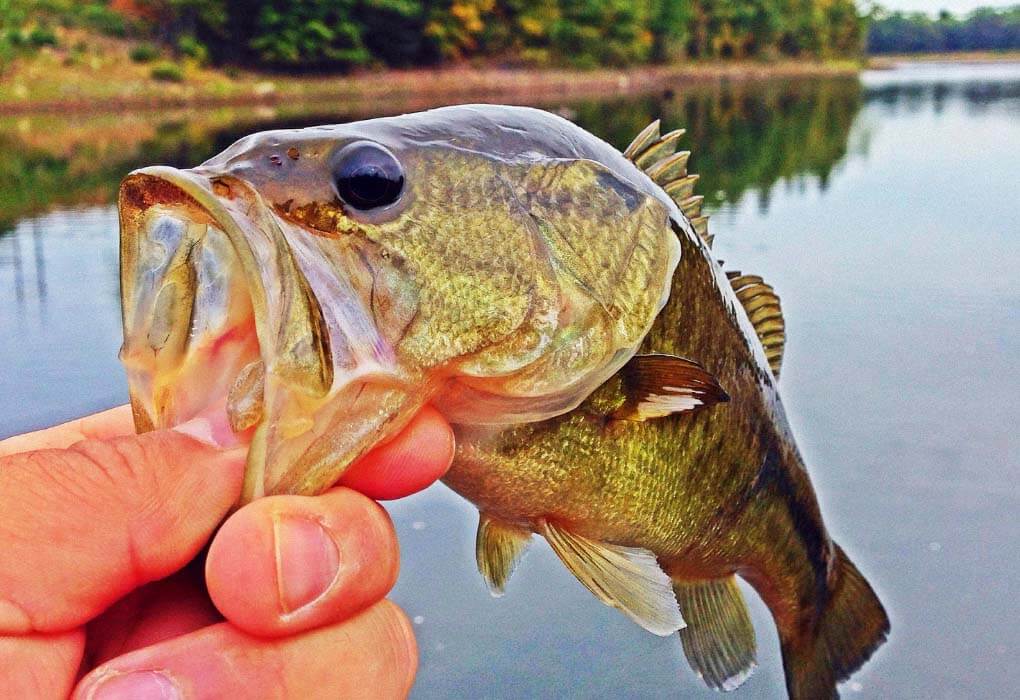
Since we’re talking about bass here, I don’t often use braided line. Even for inshore situations where I might bag a big bass, I would still use monofilament line each time.
When you use braid, you lose a lot of the sensitivity you need to catch bass. This style of fishing really relies on technique and “feel.”
You also lose that low visibility line monofilament offers. Bass are smart, but they’re also skitzy, and they will not bite something they don’t trust.
If you’re trying to bag a big one you can go for braided fishing line, otherwise stick to the thin stuff.
Many bass anglers suggest using braided lines when you’re fishing around heavy cover, heavy grass, or with topwaters braided resists line twisting much better with spinning reels than the other two options.
You can wind it tighter, which lowers the chances of experiencing any digging. Plus, I find that braided line gives you better casting distance and accuracy with the cast as well.
What Pound Test Should You Use
Many people understand the types of lines and their purposes, but it gets a little more complicated when you’re trying to choose the right size line for the fish you’re trying to catch.
There are a few things you want to keep in mind here.
First, you still need to think about the type of line you’re using.
If you’re using a monofilament line, you’re getting a lot more flexibility than you would with braided, which means that the bass will pull a little on the line before you feel the pressure.
It also means that your fishing line will snap and break much easier than it would with braided fishing line.
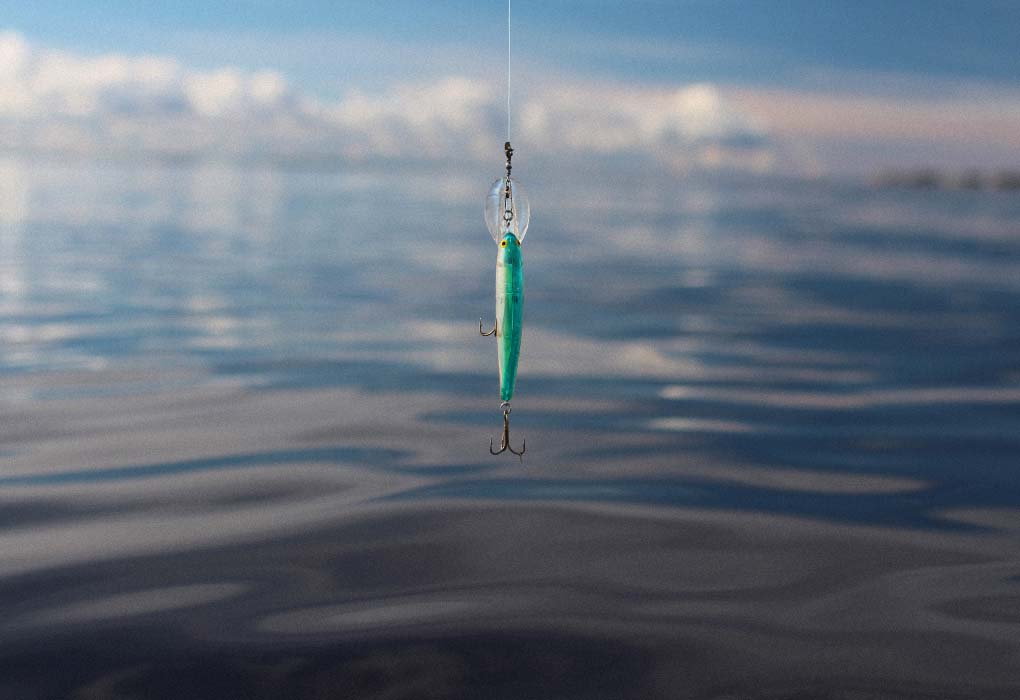
Typically, if you’re fishing finesse styles and using light topwater lures or fishing around the weeds, I would suggest using a 6-12 pound test and a spinning rod and reel combo.
This rig is ideal for finesse fishing, and it serves you the best if you aren’t trying to bring home any trophy fish.
On the other side of the token, if you’re really trolling along the heavy cover and trying to bring something home to make your family proud, then you’ll want to step up your game to a baitcasting rod and reel with at least 18 pound test monofilament or 30 pound test braided line.
Keep in mind the impact that this might have on your fishing, though, especially if you don’t have experience with lines of this size.
What Color Line Should You Use
The color of the fishing line depends a lot on the conditions. If you’re fishing around a lot of vegetation and the water has a lot of algae on the top, you might want to go with a green-tinted monofilament line.
Always remember that braided will show itself in the water more than any other line, and fluorocarbon has the lowest visibility.
The only time when line visibility becomes a real problem is with hardcore finesse style angling like light topwater, frogs, and fly fishing.
If you’re using a standard size clear monofilament line, you’re less likely to worry about the bass seeing it.
Some bass anglers prefer to go with a blue fluorocarbon or monofilament because it’s visible from above the water but not from beneath.
I’ve honestly never found it necessary to get this involved in the thought process of choosing a line color, but some anglers really believe it makes a difference.
If you’re taking my advice, go with clear all the time, and if you’re using braided try to pick something that matches your surroundings.
How Does Fishing Line Type Impact Setting The Hook
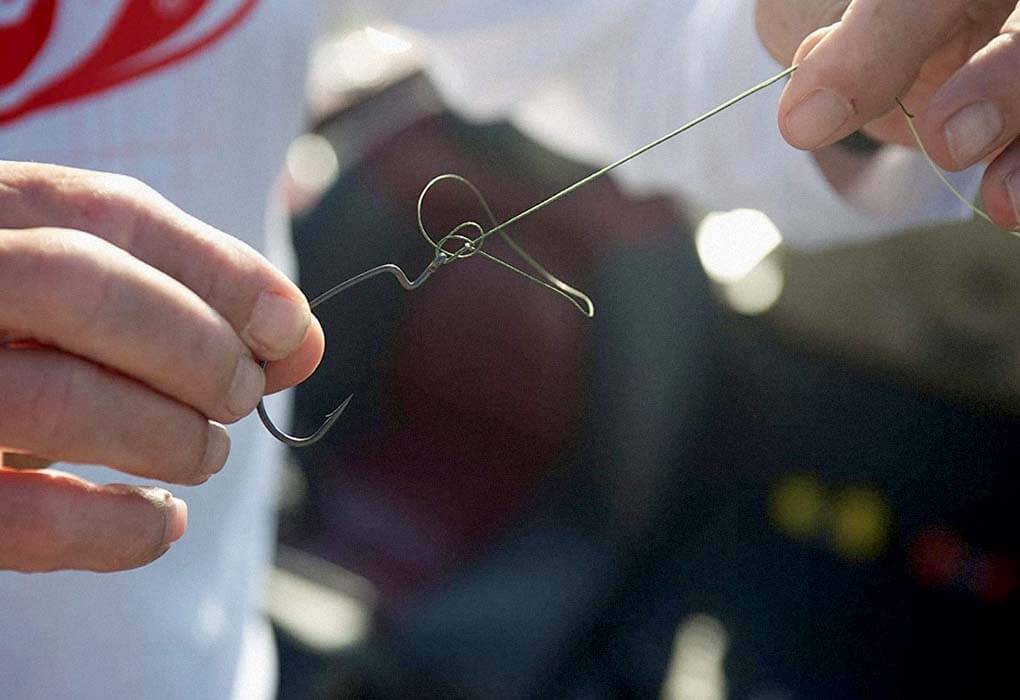
Believe it or not, the type of fishing line you use does impact how well you’ll be able to set your hook.
When you use a monofilament line, the flexibility and stretch that is built into the line makes it more challenging to get a good hookset because you won’t feel it right away.
The bass will be able to nibble and nip on your line before you even know what’s happening.
Even when you do figure out that you have a fish biting your lure, it will still take a bit longer to set the hook, and it won’t set as hard because your reaction is delayed by the flex in the fishing line.
Braided line has a higher tensile strength, which means it has zero stretch when you go to set the hook.
There’s a significant advantage here because you’ll not only feel the nibble faster and easier because of the reduced flex, but you’ll have an easier time getting a faster and harder hookset when you jerk the rod.
Fluorocarbon reacts similar to the way that braided does. It has a higher tensile strength, which means it has zero stretch and you’re less likely to miss a bite.
While these two options have their pros, they have cons as well.
Their lack of flexibility means you need to pay attention to your drag settings because if you don’t give them enough room to work the lure, you’ll end up snapping your line or losing the fish.
Understanding The Terminology
Continuing on in our bass fishing line guide, there are a few terms you’ll want to know before you start shopping around.
Pound Test – The pound test refers to the amount of weight the line can hold before it breaks. You’ll use this phrase most frequently when shopping for line.
Diameter – The fishing line diameter relates to the pound test. The higher the pound test, the larger the diameter. As a result, braided line has the largest diameter, so it also has the largest pound test.
Abrasion Resistance – There aren’t any specific ratings for abrasion resistance, but if you understand the three types of lines we discussed previously, you’ll know which lines offer the best abrasion resistance.
Line Memory – When you spool a reel and you leave the line on there, it sometimes takes the shape of the spool. Think of when you sleep in the same spot on your mattress for a long time.
The best fishing line for bass fishing will have no memory, so it will bounce back even after being spooled for months.
Line Stretch – Here, we’re referring to the amount of flexibility and elasticity the line has. Monofilament has the most amount of line stretch, and braided has the least. Line stretch is good for finesse style fishing.
Final Thoughts
Let’s take a second to recap here. Bass anglers trying to decide which line to choose for the best fishing in lakes and ponds, I would 100 percent recommend choosing the KastKing World’s Premium Monofilament Line.
If you’re trying to be a bit more stealthy by adding a leader to your line, go for the Berkley Vanish Fluorocarbon Fishing Line.
Finally, if you’re one of the many anglers looking towards surf fishing for snapper or grouper, you’ll want to use the KastKing SuperPower Braided Line.
Now you’ve got a few choices for the best fishing line for bass. Now, quit wasting valuable fishing time! Happy Angling!


